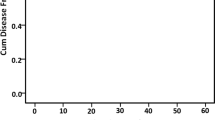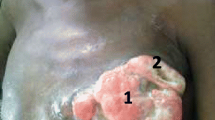Abstract
Objective
Male breast cancer (MBC) represents < 1% of all breast cancers. Hormone receptors and Her-2/neu status are established prognostic factors in female breast cancer but not yet studied enough in male breast cancer. The aim of the study was to verify the clinico-pathologic profile of male patients with breast cancer including analysis of hormone receptors and Her-2/neu state and its impact on survival rate.
Methods
This is a retrospective study carried on a total of 123 male patients presented to the National Cancer Institute (NCI), Cairo University, Egypt — with breast carcinoma from January 1999 to December 2009.
Results
The patients had a median age of 58 (ranged from 29–92) years. About 39.8% of the patients presented with T4 lesion. At presentation, 12.2% of the cases had metastasis with bone represented 86.7% of metastatic sites. About 92.7% of patients were subjected to modified radical mastectomy and radical mastectomy. Invasive duct carcinoma reported in 91.1%, and 76.4% of the patients had grade II pathology. Hormone profile was reported in 74% of the patients with 71.4% positive ER and 69.2% positive PR. Among 57 cases tested for Her-2/neu, 10.5% were positive. Luminal A was the most common subtype detected in male breast carcinoma patients constituting 66.7%. Comparison with female patients with breast carcinoma revealed some differences regarding stage, hormone profile, Her-2/neu status and breast cancer subtypes. Chemotherapy as adjuvant, neo-adjuvant and metastatic was given for 73.1%, 17.3% and 9.6% of the cases, with 83% of them had an anthracyclin-containing regimen. Sixty-nine patients received radiation treatment, 65.2% and 34.8% of them with adjuvant and palliative aim, respectively. Dose of adjuvant radiotherapy had a median value of 4410 (3400–5000) cGy. Adjuvant hormonal treatment (Tamoxafin) was given for 47 patients all of them with ER and/or PR positive for a median period of 33.5 (4–60) months. The 5-year overall survival (OS), loco-regional control (LRC), metastasis-free survival (MFS) rates were 63%, 68%, and 62%, respectively. Axillary lymph node metastasis and advanced tumor stage significantly worsen all survival rates. While, higher grade was associated with a poor overall survival, this was not reflected on LRC and MFS rates. Adjuvant radiotherapy and chemotherapy had significantly improved all survival rates.
Conclusion
Some gender differences were detected regarding stage, hormone profile, Her-2 state, and tumor subtypes.
Similar content being viewed by others
References
Korde LA, Zujewski JA, Kamin L, et al. Multidisciplinary meeting on male breast cancer: summary and research recommendations. J Clin Oncol, 2010, 28: 2114–2122.
Giordano SH, Cohen DS, Buzdar AU, et al. Breast carcinoma in men: a population-based study. Cancer, 2004, 101: 51–57.
Mokhtar N, Gouda I, Adel I. Breast cancer. In: Cancer pathology registry 2003–2004 and time trend analysis. El Sheraa, 2007, 41.
Hugh J, Hanson J, Cheang MC, et al. Breast cancer subtypes and response to docetaxel in node-positive breast cancer: use of an immunohistochemical definition in the BCIRG 001 trial. J Clin Oncol, 2009, 27: 1168–1176.
Edge SB, Byrd JC, Compton CC, et al. AJCC cancer staging manual. 7th edition. New York: Springer. 2009.
Ellis IO, Schnitt SJ, Sastre-Garau X, et al. Invasive breast carcinoma. In: World Health Organization Classification of tumors. Pathology and genetics. Tumors of the breast and female genital organs. Tavassoli FA, Devilee P, eds. Lyon: International Agency for Research on Cancer, 2003. 18–19.
Miller K. Immunohistochemical techniques. In: Theory and practice of histological techniques. Bancroft JD, Gamble M (eds). 5th edition. Churchill Livingstone, 2002. 421.
Heinrich JK, Böttcher-Luiz F, Andrade LL, et al. HER-2 and cancer antigen 125 evaluation in ovarian borderline tumors by immunohistochemistry and fluorescence in situ hybridization. Int J Gynecol Cancer, 2004, 14: 1078–1085.
Nahleh Z, Girnius S. Male breast cancer: a gender issue. Nat Clin Pract Oncol, 2006, 3: 428–437.
Anderson WF, Althuis MD, Brinton LA, et al. Is male breast cancer similar or different than female breast cancer? Breast Cancer Res Treat, 2004, 83: 77–86.
Hill TD, Khamis HJ, Tyczynski JE, et al. Comparison of male and female breast cancer incidence, trends, tumor characteristics, and survival. Ann Epidemiol, 2005, 15: 773–780.
Agrawal A, Ayantunde AA, Rampaul R, et al. Male breast cancer: a review of clinical management. Breast Cancer Res Treat, 2007, 103: 11–21.
Slamon DJ, Clark GM, Wong SG, et al. Human breast cancer: correlation of relapse and survival with amplification of the HER-2/neu oncogene. Science, 1987, 235: 177–182.
Rudlowski C, Friedrichs N, Faridi A, et al. Her-2/neu gene amplification and protein expression in primary male breast cancer. Breast Cancer Res Treat, 2004, 84: 215–223.
Carey LA, Perou CM, Livasy CA, et al. Race, breast cancer subtypes, and survival in the Carolina Breast Cancer Study. JAMA, 2006, 295: 2492–2502.
Ge Y, Sneige N, Eltorky MA, et al. Immunohistochemical characterization of subtypes of male breast carcinoma. Breast Cancer Res, 2009, 11: R28. Epub 2009 May 14.
Nielsen TO, Hsu FD, Jensen K, et al. Immunohistochemical and clinical characterization of the basal-like subtype of invasive breast carcinoma. Clin Cancer Res, 2004, 10: 5367–5374.
Ihemelandu CU, Leffall LD Jr, Dewitty RL, et al. Molecular breast cancer subtypes in premenopausal and postmenopausal African-American women: age-specific prevalence and survival. J Surg Res, 2007, 143: 109–118.
Yang XR, Sherman ME, Rimm DL, et al. Differences in risk factors for breast cancer molecular subtypes in a population-based study. Cancer Epidemiol Biomarkers Prev, 2007, 16: 439–443.
Meguerditchian AN, Falardeau M, Martin G. Male breast carcinoma. Can J Surg, 2002, 45: 296–302.
Fentiman IS, Fourquet A, Hortobagyi GN. Male breast cancer. Lancet, 2006, 367: 595–604.
Ribeiro GG, Swindell R, Harris M, et al. A review of the management of the male breast carcinoma based on an analysis of 420 treated cases. Breast, 1996, 5: 141–146.
Giordano SH, Perkins GH, Broglio K, et al. Adjuvant systemic therapy for male breast carcinoma. Cancer, 2005, 104: 2359–2364.
Howell A, Cuzick J, Baum M, et al. Results of the ATAC (Arimidex, Tamoxifen, Alone or in Combination) trial after completion of 5 years’ adjuvant treatment for breast cancer. Lancet, 2005, 365: 60–62.
Macdonald G, Paltiel C, Olivotto IA, et al. A comparative analysis of radiotherapy use and patient outcome in males and females with breast cancer. Ann Oncol, 2005, 16: 1442–1448.
Scott-Conner CE, Jochimsen PR, Menck HR, et al. An analysis of male and female breast cancer treatment and survival among demographically identical pairs of patients. Surgery, 1999, 126: 775–780.
Stranzl H, Mayer R, Quehenberger F, et al. Adjuvant radiotherapy in male breast cancer. Radiother Oncol, 1999, 53: 29–35.
Recht A, Edge SB, Solin LJ, et al. Postmastectomy radiotherapy: clinical practice guidelines of the American Society of Clinical Oncology. J Clin Oncol, 2001, 19: 1539–1569.
Truong PT, Olivotto IA, Whelan TJ, et al. Clinical practice guidelines for the care and treatment of breast cancer: 16. Locoregional postmastectomy radiotherapy. CMAJ, 2004, 170: 1263–1273.
Chakravarthy A, Kim CR. Post-mastectomy radiation in male breast cancer. Radiother Oncol, 2002, 65: 99–103.
Gennari R, Curigliano G, Jereczek-Fossa BA, et al. Male breast cancer: a special therapeutic problem. Anything new? (Review). Int J Oncol, 2004, 24: 663–670.
Author information
Authors and Affiliations
Corresponding author
Rights and permissions
About this article
Cite this article
El-Baradie, M., Salama, A., Khorshid, O. et al. Egyptian male breast carcinoma: patients’ hormonal profile, management and outcome. Chin. -Ger. J. Clin. Oncol. 11, 89–98 (2012). https://doi.org/10.1007/s10330-011-0918-0
Received:
Revised:
Accepted:
Published:
Issue Date:
DOI: https://doi.org/10.1007/s10330-011-0918-0




